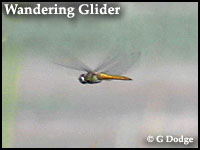 I’ve been expecting to see a Wandering Glider for some time now. On the 23rd of July one appeared at the Sailboat Pond in Catch the Wind. As their name implies, Wandering Gliders can show up just about anywhere.
I’ve been expecting to see a Wandering Glider for some time now. On the 23rd of July one appeared at the Sailboat Pond in Catch the Wind. As their name implies, Wandering Gliders can show up just about anywhere.
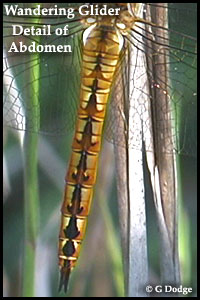 These nonstop dragonflies are widespread in their distribution – cosmopolitan. They’re migratory. They lay eggs in just about any temporary body of water including ditches and rain puddles. Wandering Gliders prefer open spaces like fields, mud flats, and ponds where they constantly patrol back and forth. I often see these yellow-gold dragonflies zipping about parking lots. It’s not uncommon to see them trying to lay eggs on the hoods of cars. Apparently, they mistake the shiny surface of the car’s hood as a pool of water!
These nonstop dragonflies are widespread in their distribution – cosmopolitan. They’re migratory. They lay eggs in just about any temporary body of water including ditches and rain puddles. Wandering Gliders prefer open spaces like fields, mud flats, and ponds where they constantly patrol back and forth. I often see these yellow-gold dragonflies zipping about parking lots. It’s not uncommon to see them trying to lay eggs on the hoods of cars. Apparently, they mistake the shiny surface of the car’s hood as a pool of water!
Another dragonfly that I discovered during this period was a Mocha Emerald — they’re brown overall and have green eyes. Unfortunately it was DOR (Dead on Road). These dragonflies are usually found at small, shaded, forested streams. This one was in Catch the Wind on the paved path near the Bird Feeders. There are several locations at the Museum where I would expect to see a Mocha Emerald. I found this one within a hundred yards of two such places.
We are entering what I call the season of the caterpillar. While there are certainly plenty of caterpillars out and about during spring and early summer, it’s now that some of the larger and more spectacular caterpillars begin to reveal themselves. They’re not always easy to find, but they do leave clues as to their presence. Partially chewed leaves and frass (caterpillar poop) on the upper surface of leaves or on the ground are good clues. We’re just on the fringe, early in the season, but we should begin to see more and more caterpillars as the season progresses and the caterpillars become more numerous and grow in size.
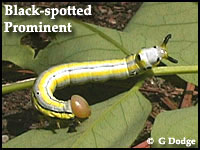 Early in this period, there were five Black-spotted Prominents on a two-foot Black Locust sapling along the path to Catch the Wind near the Bird Feeder Exhibit. The adults of these caterpillars belong to a family of mid-sized moths. The name prominent comes from the adult moth, not the caterpillar, and refers to tufts of long hair-like scales on the fore wings. However, most of the caterpillars of the various species of prominents have two tail-like projections on the rear end, some quite long and whip-like, which makes it easier to at least narrow down their identity as belonging to the prominent family, if not to species. These projections may appear to be antennae to any would be predator, but of course, the head is it at the other end of the caterpillar.
Early in this period, there were five Black-spotted Prominents on a two-foot Black Locust sapling along the path to Catch the Wind near the Bird Feeder Exhibit. The adults of these caterpillars belong to a family of mid-sized moths. The name prominent comes from the adult moth, not the caterpillar, and refers to tufts of long hair-like scales on the fore wings. However, most of the caterpillars of the various species of prominents have two tail-like projections on the rear end, some quite long and whip-like, which makes it easier to at least narrow down their identity as belonging to the prominent family, if not to species. These projections may appear to be antennae to any would be predator, but of course, the head is it at the other end of the caterpillar.
There was a mass of Red-humped Caterpillars on a tree next to the entrance to the Mist Garden in Catch the Wind during the last week of this period. There WILL be more caterpillars.
Although the Flower Garden in front of the Butterfly House has plenty of nectar-producing flowers at present, many of the flowers now blooming on the Explore the Wild/Catch the Wind Loop are not big nectar producers. What does that mean? It means that there aren’t many nectar-loving butterflies about in Explore the Wild and Catch the Wind, although a few Eastern-tailed Blues, Pearl Crescents, and Silver-spotted Skippers are still being seen.
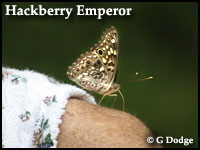 Some butterflies don’t visit flowers, or nectar. Two of those species, Hackberry Emperor and Red-spotted Purple, are both on the scene. I’ve seen Hackberry Emperors off and on throughout the season. If you happen to be walking through Catch the Wind near the Bird Feeders and a brown butterfly starts buzzing around your head and body, it’s probably a Hackberry Emperor. These butterflies have a tendency to land on people, apparently to suck up salts from sweat.
Some butterflies don’t visit flowers, or nectar. Two of those species, Hackberry Emperor and Red-spotted Purple, are both on the scene. I’ve seen Hackberry Emperors off and on throughout the season. If you happen to be walking through Catch the Wind near the Bird Feeders and a brown butterfly starts buzzing around your head and body, it’s probably a Hackberry Emperor. These butterflies have a tendency to land on people, apparently to suck up salts from sweat.
Red-spotted Purples have only recently made an appearance. They are large black butterflies with iridescent blue on the hind wings. They do not have the “tails” on their hind wings as do the large black swallowtail butterflies in our area. Reddish spots can be seen when the butterfly folds its wings over its back. They fly rapidly and erratically. Don’t look for them on flowers but on the ground (especially wet ground) or sitting on a tree leaf.
Female Cicada Killers have emerged (see Explore the Wild Journal, July 1-15, 2008).
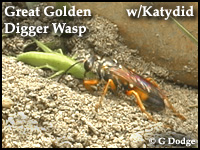 Great Golden Digger Wasps are also active at this time. These large wasps (not as large as Cicada Killers) also dig burrows in the ground. They stock their burrows with Katydids or Grasshoppers (image here). They visit flowers often, so keep an eye out for them on the Boneset or Goldenrod when it’s in bloom.
Great Golden Digger Wasps are also active at this time. These large wasps (not as large as Cicada Killers) also dig burrows in the ground. They stock their burrows with Katydids or Grasshoppers (image here). They visit flowers often, so keep an eye out for them on the Boneset or Goldenrod when it’s in bloom.